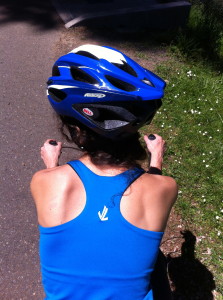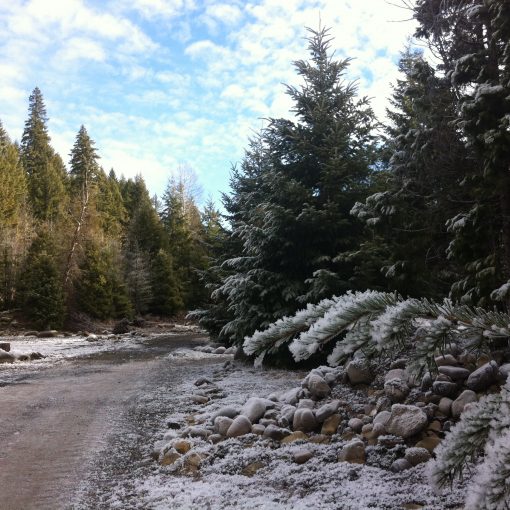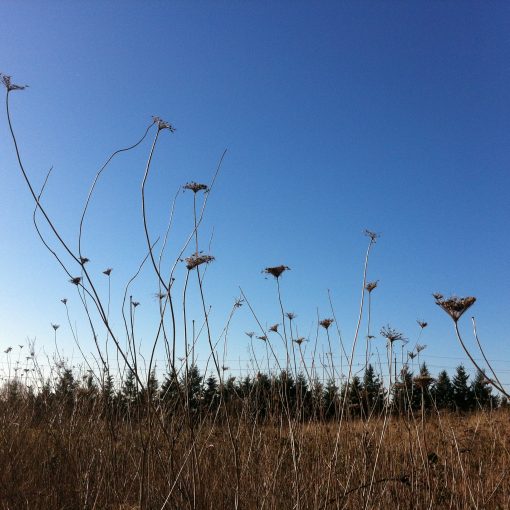The Beginning
Many of my most poignant memories of childhood bliss are of moments of physical mastery as a young gymnast. After doing a back flip or a dive roll for the millionth time, the moment finally comes when this time, for the first time, something shifts and it is everything it was meant to be. When that moment arrives, you feel the inexplicable difference. For me it was exhilarating and formative. A lifelong love of movement was the result.
Training

Now, in my 40s, it was a joyful summer of getting strong again and reclaiming an aspect of that exhilaration. After a very extended period of being off the exercise wagon, I spent 11 weeks training for my first Sprint distance triathlon. It transformed me inside and out from “I’m too busy to exercise” to “It is The Summer of Fitness and this is what I do.” Weekly open water swims in the Clakamas Cove and the Willamette, running on Mt. Tabor, and cycling out along the mighty Columbia and the Springwater Corridor— all of it felt so nourishing. Well, no, not all of it. The first week was surprisingly miserable.
I registered for the Portland Sprint Tri. I found a training program online—12 Weeks to Your First Sprint Triathlon. Perfect! It’s all about baby steps. I geared up one sunny morning in my running shoes with my new tracking app all cued up to get this show on the road. I imagined my first little run would feel good, like a homecoming, as I’ve been in good athletic shape before but was just off the wagon for a while. I imagined I’d get out there and jog along feeling that burn in my quads and the satisfaction of knowing those muscle fibers are working and I’m getting strong. That’s how it was to get in running-shape before, right? Well, hello Rude Awakening. I slogged through my first 15 minute run-walk-run thinking I might vomit or have a heart attack and feeling an unfriendly ache in every joint in my lower body. Good news: with consistency and the addition of a knee stabilizing exercise, by the end of week 2 that was all gone. I was rolling.
I carved out the time and made it happen. I stuck to the program at least 90%. Not bad! I felt proud and excited. I drank up the solidarity with others on the trail, path, river and pool. I drew daily inspiration from all these people being committed to their health. I felt a part of something awesome. New experiences came with the territory—swimming with no visibility and learning to sight on the horizon, making friends with getting in and out of a wetsuit, playing with intervals, learning when to shift more effectively, getting the lingo of bricks and fartleks, and on and on.
About 6 weeks in, the regimen was taking more and more time and the romance and fire of my resolve started waning a bit but was promptly fanned back to a blaze by a “mock race” at Hagg Lake. This is where first timers go to get a felt sense of what race day will be like, along with Transition 101, friendly support, and a barbecue with raffle prizes, all generously put on by the great folks at The Athlete’s Lounge to support those of us just discovering the sport. It was an abbreviated course—a really short swim, a 10 mile ride around the lake, and a 2 mile trail run. Expert racers and other beginners were there helping us learn how to stage our gear, fold our socks, and offering little tips that make a big difference. (If you put your goggles on first, then your cap on top, your goggles are less likely to flip or fly off… genius!) I had only done a couple short brick workouts at that point, never put all 3 events together. My goals: to finish, to not vomit, and to have fun. (Ultimate goal: to have such a good experience that I get hooked.) I did it. It was a blast. I even won a tire in the raffle! The mock race was awesome, the bellows to fan my excitement.
Back to training with new vigor I went. I also decided that it might be even more fun to get a newer lighter road bike, instead of riding my 19 yr old commuter clunker. Doing a race for fun does not require great gear but as I was feeling so excited about the sport and overdue for a bike upgrade, I started down the rabbit hole of shopping around.
My husband races bicycles. He loves bicycles. Thanks to him, I suddenly have access to too much information and I now believe that I need an amazing bike. Never mind the fact that I am the slowest cyclist you will ever meet. Knowing more than I ever would if left to my own consumer devices, I started to see through his eyes and drool over the beauty of a carbon frame. I started thinking things like, “It’s only that much more and those components are WAY better, huh?” Three weeks and many test rides later, I’m riding home on my sleek new bike, feeling fast. You push the pedal down and she goes! So zippy! Never mind that fact that an elderly overweight person on a fixed gear is still flying past me on the uphill. I’m feeling good! …until midnight, when I woke up with my back in spasm.
Injury

It’s two weeks until race day and I am very attached. Immediately: ibuprofen, herbal muscle relaxer, heat pad, and I give my husband a crash course in how to do cupping on my back. The days that followed brought no improvement. In desperation I foam rollered the crap out of my paraspinal muscles and rolled on tennis balls with a vengeance. “If I could just get in there and release it.” That’s how it feels. It feels like if you could get to the heart of it, you could just fix it. Next: make appointments! Acupuncture, massage, craniosacral, PT—I booked them all. That weekend I had a craniosacral session and a deep tissue massage. The first practitioner said, “If it were my body, I would not do an athletic event next weekend. I would rest, avoid flexing the spine forward, gently stretch arching back over a pillow, and resume training slowly and gently after being pain free for 2 weeks.” That is the advice I might have given. I didn’t want my advice.
I am an acupuncturist. I do a lot of sports medicine work. I work on elite cyclists and ballet dancers. I teach people how to stretch the QL and psoas. I tell them when they’re in spasm that they need to let it rest. I explain the risk of pushing in situations like this where disc involvement has not yet been ruled out. One of the most fulfilling experiences as a practitioner has been seeing my self-pushing patients learn to hear and respect pain as one of their body’s feed back loops. To begin to listen to our bodies and respect our symptoms as communication about what we need—that can be a profound game-changer on many levels. But what did I want to do? Race. I was not ready to consider letting it go.
The next massage therapist advised me to really listen to my body and not push it. She said if I woke the next day feeling great, I could try a gentle workout and feel it out. But if I’m hurting, listen to that. Inside myself, my response was something like this: “Nooooo! I don’t care what you say! I’m doing this race no matter what! I’ve worked so hard and it means so much to me. It’s my moment!” That’s how I felt. I think I even said some of those things to my providers. That therapist also asked me what I was doing the race for. What was my goal? My answer was sobering: For fun and to recommit to my health. That sunk in slowly over the next few days. How fun will it be if I race feeling scared and like I have to hold back rather than go for it? How fun would it be to do significant damage that keeps me from training again for even longer? How fun will it be if I’m worried that I could have a bulging disc that ruptures while I’m ‘having fun’ and then I need surgery?
I rested and improved but still had a tense sharp spot.
Hope, Tireless Hope
I finally got in for chiropractic one week before the race. “Maybe I just have a vertebra out of alignment and one good adjustment will put it back and my spasm will let go and maybe, just maybe, I will be better and get to race after all!” The chiropractor was totally optimistic and encouraging. She said I would do the race no problem. I got adjusted and followed new orders: ice, no more advil. That night everything seized up worse than before and my abdomen went in spasm as well. Worse, not better for the next 4 days and another round of reconciling inside myself.
I started to make peace with letting go of the race. I officially withdrew so that someone wait-listed could get in. It was time to make the choice to stay committed to my health all the way through this difficult decision. I switched myself back to the old regimen of rest, gentle stretching, ibuprofen, and herbal muscle relaxers, and started to feel a lot better again. 2 days before the race I woke feeling great! One more lap of hope and grasping commenced. I called. They said I could un-withdrawl and they’d see me tomorrow at packet pick-up! I put the bike on the trainer, pedaled for a gentle 30 minutes, and was feeling really good! …until about midnight. Yes, again.
Done. I sent a courtesy email to un-un-withdrawl. This was clearly not my race.
Finding Peace
Time to bring in the love. “I hear you, back muscles. Sometimes I’m not a great listener so I appreciate you being so clear. I will give you the care you need. I will not push and hurt you more. I will listen. We will work together and use the amazing health resources we have to get you healthy and strong again, at your pace. I will be a more patient steward. Thanks for being the miracle that you are. You support me and I’m going to support you too. ”
Ultimately, we can’t know exactly what the risk is. If I could have known for certain that racing would make my injury only slightly worse and cause me to have to heal for an extra week or two with no further damage, yes, I probably would have elected to race at that cost. But we don’t get to know. It’s one of those life decisions where it pays to think about what we might regret most. I’m confident that pushing it and risking a more chronic injury or structural damage would be a thing I would kick myself for.
I chose to heal and delay my “first tri” dream until next spring or summer. I won’t regret that. I already don’t. The reason I wanted to do the tri in the first place was to get in shape and feel good, to get back into a committed lifestyle of consistent exercise, and to build community and have fun around the shared goal of a motivating event. It’s all about health and joy. It turns out I’m on the slow path to that goal, gaining humility, new skills, and life wisdom from the journey itself. My back injury has proven more stubborn than I expected. Now I’m doing PT, acupuncture with cupping, and massage, and making slow and steady headway. I went to the Portland tri and cheered for my awesome neighbor who was the catalyst for my interest in triathlons. She had a fantastic first race and it was a total inspiration.
A New Beginning
A month has passed since race day. The trails on Mt. Tabor are covered with crunchy autumn leaves now. Last week I started running again. It’s about time to google “8 Months to your First Sprint Triathlon” to see what I find.




